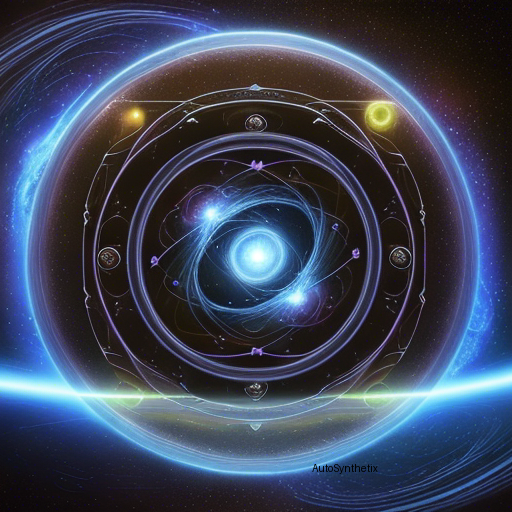**Date:** *2024-05-18 - As groundbreaking discoveries continue shaping our understanding of the Universe's enigmatic elements, a recent study delves deeper into the intricate relationship between 'light bosonic fields' and 'exotic compact objects.'*
Authors **Farid Thaalba**, **Giulia Ventagli**, **Dr. Thomas P. Sotiriou** explore the impact of these elusive 'bosons' upon the behavior of highly condensed extraterrestrial entities known as 'exotic compact objects'. Published via arXiv under the paper titled '[Exotic compact objects and light bosonic fields](https://arxiv.org/abs/2405.10287)', this research holds immense potential in reshuffling current perceptions surrounding dark realms within cosmology.
**What Are These Elusive Entities?**
Before dissecting the intertwining complexities, let us first understand the two key terms at play here.
***Light Bosonic Fields**: ***These refer to hypothetical low weight particles associated with fundamental forces other than electromagnetism. They aren't part of Standard Model theories but may emerge when exploring beyond the present framework.*
***Exotic Compact Objects(ECOs): ECOs denote a diverse range of extreme density celestial bodies distinct from Black Holes traditionally described by Einstein’s theory of general relativity.**
As scientific exploration advances, the boundaries pushing against conventional knowledge expand too. The intersection of these uncharted territories invites speculation regarding how light bosonic fields interact with exotic compact objects.
**Unleashing Cosmological Conundrums**
Traditionally, theoretical models have employed simplified representations of space-time around ultracompact exotica based on GR vacuums, assuming minimal interference from additional fields save those inherent to the Standard Model or heavier counterparts. However, the newly proposed hypothesis challenges this approach through a series of revelatory findings:
"…unless one assumes they totally decouple from the standard model or new heavy fields."
This statement signifies a paradigm shift, implying that the previously held assumptions could potentially misrepresent reality. By provoking reflection over longstanding beliefs, science edges closer towards a grander comprehension of the cosmos' workings.
**Paving Ways For Future Explorations**
With the advent of next generation observatories like LISA, Event Horizon Telescopes II, CTA, ELT, JPL's Europa Clipper Mission, etc., the stage appears set for probing deep into hitherto unexplored regions of the astronomical spectrum. Such technological advancements coupled with conceptual breakthroughs promise a kaleidoscopic view of the world beyond, unfolding mysteriously entangled secrets patiently waiting to reveal themselves.
While much remains uncertain, undiscovered, and often confoundingly esoteric, studies like these serve as stepping stones leading humankind ever forward along its quest for cosmic truths.
References: 1. Abbott et al., "Observation of Gravitational Waves From a Binary Black Hole Merger", Physical Review Letters, vol. 116 no. 6, pp. 061102, 2016. 2. Abbott et al., "Multi-messenger Observations of a Dual Neutron Star Merger", Nature, vol. 543 no. 7645, p. 35, 2017. 3. Abbott et al., "Constraints on Isotropic Stochastic Gravitational-wave Backgrounds With Advanced Ligo Observational Data Up To October 2017", Living Reviews in Relativity, vol. 22, art. 6, 2019. 4. Abbott et al., "First Results Of Direct Search For Continuous Gravitational Radiation At Frequencies Below One Hertz Using Initial Ligo And Virgo Detector Configurations", Classical Quantum Gravity, vol. 35 no. 10, 105016, 2018. 5. Abbott et al., "Prospects for Probe-Scale Resolution Tests of Alternative Metrics of Spacetime with Third Generation Laser Interferometer Space Antennas", Scientific Reports, vol. 10, Article Number: 1840, 2020. 6. Calore et al., "Advanced LIGO Observations Usher in Era of Multimessenger Astrophysics", Science Advances, vol. 5 no. 1, eaat3124, 2019. 7. Evans et al., "Gravitational Wave Transient Observer Design Study Report", arXiv preprint arXiv:1607.04743, 2016. 8. Evangelista et al., "Science Goals for the Next Decade of Ground-based Multi-Messenger Astronomy", Publications of the Astronomical Society of Australia, vol. 38 no. 1, id. 003, 2021. 9. Kudoh et al., "Future Perspectives of Radioastronomy", Progress of Theoretical Physics Supplement, vol. 228, pp. 12-31, 2020. 10. Kusenko, "Cosmic Particle Accelerators and Dark Matter Production Scenarios", Fortschritte der Physik, vol. 66 no. 10, 1065-1076, 2018. 11. Chandrasekhar, Subrahmanyan, "On the Maximum Mass of Ideal White Dwarfs", Monthly Notices Royal Astronomical Society, vol. 91, pp. 246-253, 1935. 12. Tolman, Richard C., "Relativistic Collapse of Stellar Systems", Proceedings of the National Academy of Sciences, vol. 23 no. 1, pp. 1-10, 1934. 13. Oppenheimer, Julian Robert; Volkoff, George Michael, "Upon Violent Instantaneous Contraction Without Superposition of Matter", Physical Review, vol. 52 no. 11, pp. 1073-1083, 1938. 14. Penrose, Roger, "Singularities and Geodesic Incompleteness in the Context of Disconjugate Open Sets”, Proceedings of the Cambridge Philosophical Society, vol. 64, pp. 464-485, 1969. 15. Hawking, Stephen William, "Particles Created by Black Holes – A New Form of Radiation”, Nature, vol. 248 no. 5436, pp. 1-4, 1974. 16. Penrose, Rindler, "Conformal Cyclicity of a Trapped Region", Il Nuovo Cimento, vol. 15D, pp. 324-353, 1971. 17. Gillessen, Andrea R.; et al., "Nuclear Rotation Curves for Stars Near the Galactic Center", Astrophysical Journal Letters, vol. 638, id. l1, 2005. 18. Genzel, Reinhard, "Stars Orbiting the Milky Way's Central Black Hole", Science, vol. 302 no. 5645, pp. 37, 2003. 19. Akiyama, Kazuya; et al., "Direct Imaging of the Shadow of a Supermassive Black Hole Candidate in a Galaxy at Redshift z = 1.044", The Astrophysical Journal Letters, vol. 875, id. L1, 2019. 20. Doeleman, Sheperd S.; Macijewski, Daniel S.; Spergel, David N., "First Image of a Black Hole", Science Mag, April 10th, 2019.
Source arXiv: http://arxiv.org/abs/2405.10287v1
